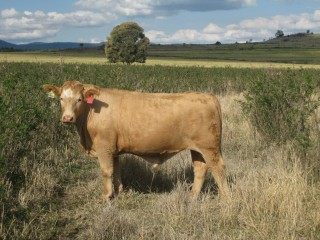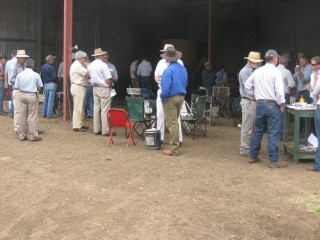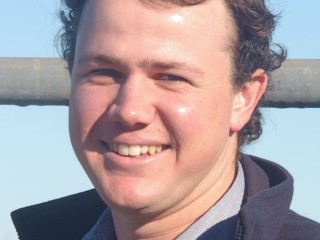A three-year trial underway in Queensland is examining the economics of four different finishing systems for cattle – improved pastures, leucaena, oats and grain feeding.
 A group of similar steers with otherwise identical backgrounds was split in mid-November 2010, with 69 steers moved onto leucaena-grass pastures, and 18 moved onto improved pastures comprising mainly Bambatsi and green panic.
A group of similar steers with otherwise identical backgrounds was split in mid-November 2010, with 69 steers moved onto leucaena-grass pastures, and 18 moved onto improved pastures comprising mainly Bambatsi and green panic.
Seven months later, in June last year, the steers on leucaena were split three ways onto oats, into the feedlot and back onto the leucaena, with the aim of finishing them before the end of the year. The steers on the improved pastures were retained on the improved pasture throughout.
The costs and returns from each group were then compared at the end of the period to assess which produced the best economic result.
The analysis forms part of a Producer Demonstration Site (PDS) trial at Ranald and Sally Ferrier’s Bell district finishing property, Bonnie Doon, located 40km north of Dalby on Queensland’s Darling Downs.
The three-year trial is being coordinated by Department of Employment, Economic Development and Innovation FutureBeef extension officers, Tim Emery and Roger Sneath, with funding support from Meat and Livestock Australia. The day-to-day duties involved with the trial are undertaken by Bonnie Doon manager, Stephen Munge, and staff.
In the first year of the trial, 69 EU steers were run together on leucaena-grass pastures from November 12, 2010 until June 3, 2011. The group was then split three ways onto oats, into the feedlot and back onto the leucaena. Another group of 18 EU steers was retained on grass for the entire 12 month period.
Weight gains were recorded at regular intervals, along with faecal samples collected to map the ongoing quality of the diet provided by each finishing system.
At the end of the first 12 month period, DEEDI economist Fred Chudleigh crunched the numbers to provide a measure of the economic performance of each system.
 The results from the first year of the trial were released at a field day on Bonnie Doon just before Christmas last year.
The results from the first year of the trial were released at a field day on Bonnie Doon just before Christmas last year.
At the same time, 100 new EU steers, averaging 350kg, entered the trial. This group will also be monitored over the next 12 months on similar finishing systems.
First year results
The tropical legume leucaena was initially introduced to Australia to provide a year-round protein source in northern areas. However its footprint is gradually pushing further south as newer varieties prove their ability to withstand frost.
Among other things, the Bonnie Doon trial is providing cattle producers in southern Queensland with an objective look at how the leucaena option stacks up against their more traditional finishing systems of grass, oats and grain.
The initial results are looking promising for leucaena, with the legume producing an average daily weight gain over the 12 month period of 0.71 kilograms per head per day, which compares to 0.58kg/hd/day for grass. The average daily gain on oats was 0.77kg/hd/day until 23 September 2011 (or 0.71kg/hd/day when the tail was included until 11 November 2011) and for the feedlot was 1.56kg/hd/day (no HGPs).
The grass system produced 130kg/ha of liveweight gain and the leucaena system produced 260kg/ha over the 12 months.
Stocking rates for the non-grain options equated to 4.1 acres (1.7 hectares) per head for grass, 1 acre (0.4 hectares) per head for oats and 2.5 acres (1 hectare) per head for leucaena.
In terms of the cost of gain, cattle on leucaena gained each kilogram for an average cost of $0.61/kg, followed by grass $0.68/kg, oats $1.75/kg and the feedlot $2.04/kg.
 All the finishing systems produced highly profitable results, Mr Emery said, but the three high input systems were more profitable than the 12 month improved pasture system under the seasonal conditions and prices encountered.
All the finishing systems produced highly profitable results, Mr Emery said, but the three high input systems were more profitable than the 12 month improved pasture system under the seasonal conditions and prices encountered.
More comprehensive analysis of the detailed results, including how each finishing system performed on the measure of “partial return on livestock capital invested” (which takes into account the different capital investments necessary to make the steer finishing systems operate and therefore makes adjustment for the differing stocking rates and periods of time) can be obtained by contacting FutureBeef’s Tim Emery at tim.emery@deedi.qld.gov.au or (07) 4622 9903
Very wet conditions in early 2011 impacted on weight gains across the group, a problem experienced by most producers across Southern Queensland as a result of widespread rainfall and three-day sickness at the start of last year.
More than 50 producers attended the December 2 field day where they were presented with detailed updates on the production and economic performance of each group.
The field day was the third conducted at Bonnie Doon over the past 12 months. Guest speakers have included DEEDI economist Fred Chudleigh, Queensland Climate Change Centre of Excellence’s Dave McRae, North Australia Pastoral Company’s Stewart Taylor, Integrated Animal Production nutritionist Dr Rob Lawrence, DEEDI extension officer Dave Lawrence and Riverina Stockfeed’s Glen Whitton.
Mr Emery said further field days would be held this year, showcasing the progress of the second group of steers and the paddocks involved in the demonstration.
